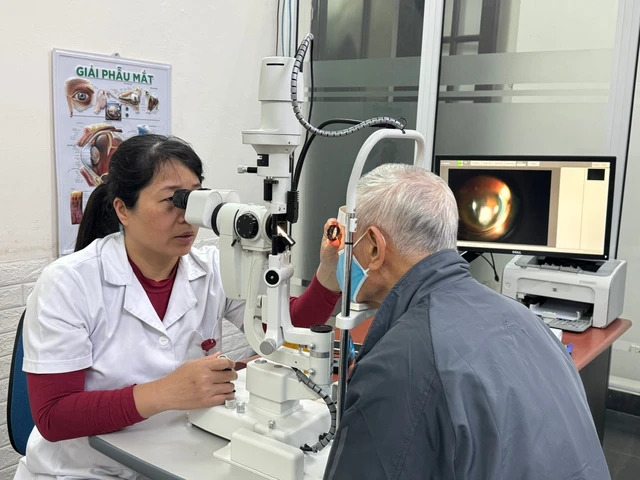 Society
Society

 |
| Doctor examines the eyes of a diabetic patient at HITEC Hospital. — Photo courtesy of the hospital |
HÀ NỘI — Experts shone a light on a pressing healthcare concern at a scientific symposium on Thursday in Hà Nội, as they gathered to chart a national strategy for battling diabetic eye disease – the leading cause of vision loss among working-age adults in Việt Nam.
The symposium, titled 'Towards Building a Comprehensive Management Model for Patients with Diabetic Retinopathy and Diabetic Macular Oedema at Hospitals,' was organised by the Medical Service Administration under the Ministry of Health, in partnership with the Việt Nam Medical Association and Roche Pharma Vietnam.
The discussion addressed the urgent and growing challenge posed by diabetic retinopathy (DR) and diabetic macular oedema (DME). In a 2020 survey, approximately seven million people in Việt Nam were living with diabetes, more than half of whom remain undiagnosed – forming a vast 'iceberg' of hidden risk, with 39.5 per cent facing eye or nerve complications.
Compounding the issue, six in ten diabetic patients are believed to suffer from eye-related complications, yet a mere fraction receive early screening and diagnosis. As of 2016, it is estimated that around 320,527 individuals in the country had DME.
A particularly stark example was highlighted from the formerly Bà Rịa–Vũng Tàu Province (now part of HCM City), where of an estimated 18,000 patients with DR and DME, only 600 were recorded as receiving outpatient treatment at the provincial eye hospital.
Experts attributed this alarming shortfall to low public awareness, limited access to healthcare services and the financial burden on patients. These obstacles have resulted in delayed intervention, leading to irreversible vision loss and blindness. As a result, there is a critical need for a coordinated, multidisciplinary approach to improve screening and treatment strategies.
 |
| Deputy Director of the Medical Service Administration Nguyễn Trọng Khoa speaks at the symposium. — Photo courtesy of the organiser |
Deputy Director of the Medical Service Administration Nguyễn Trọng Khoa underscored the importance of mounting such a comprehensive management model within hospital settings.
"This not only helps improve the quality of treatment for patients but also contributes significantly to the development of ophthalmology departments at hospitals, especially at the provincial level. The application of new technologies like artificial intelligence (AI) in early screening is also a positive direction that we encourage,” said Khoa.
The symposium outlined a phased plan for implementation: the period from 2025 to 2027 will focus on piloting the model in key hospitals. Drawing on pilot outcomes, a national guideline will be developed by 2027, paving the way for a broader rollout between 2028 and 2030.
The ultimate aim is ambitious but necessary – to raise the rate of diabetic patients screened and monitored for eye disease to over 75 per cent by 2030, aligning with the national strategy for blindness prevention.
Director of the National Eye Hospital Assoc. Prof. MD Phạm Ngọc Đông pledged the hospital’s full support.
“Our goal is to support diabetic patients in getting early diagnosis and treatment for eye complications, helping to preserve their vision and improve their quality of life, particularly for those of working age,” he said.
The symposium concluded with a strong consensus on the need to establish a multidisciplinary expert group and a robust coordination mechanism among stakeholders.
Its outcomes now form a critical foundation for future efforts aimed at reducing the burden of DR and DME – protecting vision and enhancing the lives of diabetic patients across Việt Nam. — VNS




